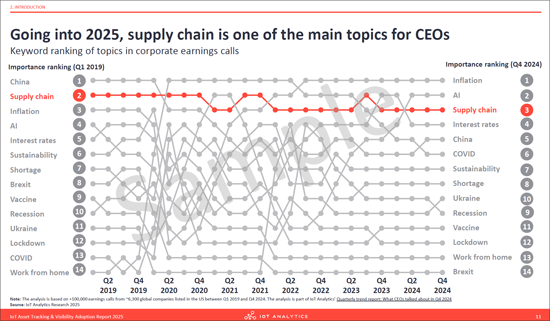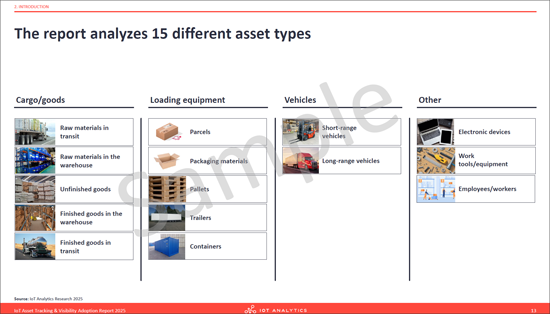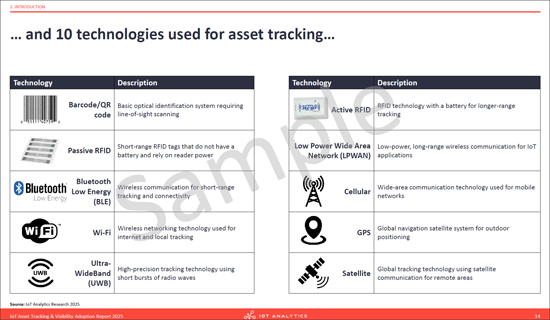PUBLISHER: IoT Analytics GmbH | PRODUCT CODE: 1697452

PUBLISHER: IoT Analytics GmbH | PRODUCT CODE: 1697452
IoT Asset Tracking & Visibility Adoption Report 2025
A 142-page report on enterprise asset-tracking projects in manufacturing, mfg. supply chains, construction, retail, energy, incl. insights on implementation, vendors in use, spending patterns, ROI, challenges, and success factors.
The "IoT Asset Tracking & Visibility Adoption Report 2025" is part of IoT Analytics' ongoing coverage of the IoT in general. The information presented in this report is based on an extensive survey of 100 adopters of asset-tracking solutions in the manufacturing, retail, and construction industries. The purpose is to inform other market participants about the current state of asset tracking across companies. Survey participants were selected randomly, and their knowledge was verified independently. To ensure complete objectivity, IoT Analytics did not alter or supplement any survey results and did not accept participants who were suggested by third parties (e.g., customers from specific vendors)-and where it's heading.
SAMPLE VIEW


Understand the current state of IoT asset tracking adoption
The "IoT Asset Tracking & Visibility Adoption Report 2025" is a data-centric market research publication by IoT Analytics. It explores the real-world adoption of IoT-based asset tracking and visibility solutions. Based on a global survey of 100 qualified decision-makers, the report investigates how companies track physical assets using technologies like GPS, RFID, and IoT sensors. It highlights adoption levels, tracked asset types, vendor involvement, and spending patterns across industries, offering C-level executives and strategists a comprehensive reference point for benchmarking.
SAMPLE VIEW


Structured analysis across key areas of asset tracking
The report is organized into clearly defined chapters, each covering a specific aspect of IoT-based asset tracking and visibility adoption:
- Executive summary. Highlights of the key findings and conclusions from the survey analysis.
- Introduction. Context and definitions, including the scope of asset types, environments, and visibility goals.
- State of asset tracking. Examines which assets are tracked, how many, which attributes are monitored, and the implementation footprint across use cases.
- Technology insights. Reviews tagging technologies, connectivity protocols, software platforms, integration levels, and data transmission frequency.
- Vendor insights. Details which solution providers are used, customer satisfaction levels, and vendor strengths/weaknesses.
- Drivers, success factors & challenges. Covers project goals, implementation bottlenecks, and best practices.
- Spending, ROI & business outlook 2025. Discusses current and planned investment levels, ROI findings, and future expectations.
- Methodology and appendix. Outlines survey methodology, respondent demographics, and additional charts.
Insights into what companies are doing in the field
The report provides a detailed snapshot of how companies are applying IoT-based asset tracking today. Based on end-user input, it allows market participants to understand what is being tracked, how it is being tracked, and why:
- Asset types and tracked data. Understand which assets are being monitored and what attributes-like location, temperature, or vibration-are tracked by end-users.
- Scale of deployment. See how many assets are currently tracked per type and what share of total assets companies aim to monitor in full rollouts.
- Technology and integration. Learn which connectivity technologies and sensor types are used in practice, how often data is transmitted, and how tracking systems are integrated into enterprise platforms like ERP or inventory management.
- Software and use cases. Discover which software platforms support tracking and what use cases-such as theft prevention, predictive maintenance, or inventory optimization-are actively enabled by users.
- Vendor landscape. Identify which solution providers are being used, what parts of the solution they deliver, and how satisfied users are with their performance.
- Spending and ROI. Benchmark how much companies are spending annually, how budgets are expected to change in 2025, and what levels of ROI are achieved across asset types.
- Implementation realities. Gain insight into how end-users select solutions, handle time-sensitive data, overcome deployment challenges, and what they cite as key success factors.
A downloadable sample of the report is available to preview the structure, explore example insights, and assess the data depth. It provides a grounded foundation for organizations looking to benchmark or plan their IoT asset tracking initiatives.
Questions answered:
- Which are the most tracked assets and what is being tracked for each asset?
- Which use cases are enabled from asset-tracking solutions?
- Which are the most used tracking technologies, and which company systems are integrated with the tracking solution?
- How scalable/integrated are the implemented solutions, and how is the data transmitted/analyzed?
- Which are the most used vendors, and how satisfied are their customers?
- What are the strengths and weaknesses of individual vendors in the market?
- How are adopters selecting asset-tracking solutions?
- What challenges did they face when implementing, and what tips do they have for a successful implementation?
- What ROI have companies seen from their implementations, and how did this meet their expectations?
- How much are companies spending on asset tracking and how is that spending expected to develop in 2025?
Companies mentioned:
A selection of companies mentioned in the report.
|
|
|
|
Table of Contents
1. Executive Summary
2. Introduction
- 1. What is Asset Tracking in the context of this report
- 2. Asset tracking plays a crucial role in companies' supply chains
- 3. Going into 2025, supply chain is one of the main topics for CEOs
- 4. The interest in search terms related to asset tracking and supply chain is slowly growing
- 5. Companies with a focus on asset tracking are seeing the results of that interest
- 6. There are many reasons why companies adopt IoT asset-tracking solutions
- 7. The report is segmented into 5 chapters
- 8. The report analyzes 15 different asset types
- 9. ... and 10 technologies used for asset tracking...
- 10. ... based on a survey of 100 end-users of asset-tracking solutions
- 11. Examples of companies who participated in the research
3. State of asset tracking
- 1. Chapter 3: State of asset tracking - Overview and key takeaways
- 2. Asset tracking overview
- 3. What is driving asset tracking in the Pharma and F&B industries: Cold chains
- 4. Types of assets tracked
- 5. Tracking examples: Unfinished goods in production - Example: Denchi tracks unfinished batteries in production using barcodes.
- 6. Tracking examples: Employees/workers - Example: Salco tracks workers using a UWB solution.
- 7. Tracking examples: Parcels - Example: Altru tracks parcels using Bluetooth-enabled sensors.
- 8. Number of assets tracked
- 9. Asset attributes tracked
- 10. Tracking temperature: Sensitech provides a platform to see asset temperature over time and accepted ranges
- 11. Tracking Utilization: Samsara provides special "Utilization Reports" that show how often assets are used
- 12. Asset tracking use cases: Overall
- 13. Asset tracking use cases: By asset type
- 14. Asset tracking use cases: By region, and company size
- 15. Asset tracking use cases: By industry
4. Technology insights
- 1. Chapter 4: Technology insights - Overview and key takeaways
- 2. Connectivity technologies: Overview
- 3. Connectivity technologies: By asset type
- 4. Tracking shipping containers: Hapag Lloyd uses a mix of satellite and cellular technologies
- 5. Software and platforms that support asset tracking: Overview
- 6. Software and platforms that support asset tracking: By asset type
- 7. Platform example: Integrating into SAP ERP
- 8. Platform example: Oracle's EAM Asset Management solution
- 9. Platform example: Verizon's Fleet Management solution "Verizon Connect Reveal"
- 10. Technology highlights: Overview
- 11. Technology deep-dive: Scalability of asset-tracking solutions
- 12. Technology deep-dive: Integration with company systems
- 13. Integration affecting success of tracking projects
- 14. Technology deep-dive: Data transmission frequency
- 15. Data transmission frequency affecting success of tracking projects
- 16. Technology deep-dive: Analysis urgency of asset tracking data
5. Vendor insights
- 1. Chapter 5: Vendor insights - Overview and key takeaways
- 2. 10 most mentioned asset-tracking vendors: Overview
- 3. 10 most mentioned asset-tracking vendors: Satisfaction & expectations
- 4. 10 most mentioned asset-tracking vendors: By asset tracked
- 5. Extensive list with all vendors that respondents have worked with
- 6. Connectivity technologies and hardware offerings of select vendors
- 7. Overview: Vendor strengths and weaknesses
- 8. Opinion deep dives: Vendor strengths
- 9. Opinion deep dives: Vendor weaknesses
- 10. Opinion deep dives: By vendor: SAP, in-house, and Oracle
- 11. Opinion deep dives: By vendor: IBM, Microsoft, Honeywell, Zebra, Samsara
- 12. Opinion deep dives: By vendor: Verizon, Project44, Asset Panda
6. Drivers, success factors & challenges
- 1. Chapter 6: Drivers, success factors & challenges - Overview and key takeaways
- 2. Overview: Asset-tracking implementation drivers & decision-making criteria
- 3. Top decision-making criteria for asset-tracking solutions: By region, industry, and company size
- 4. Top decision-making criteria for asset-tracking solutions: By detailed industry
- 5. Decision-making criteria deep-dive: Overview
- 6. Example: Cost of asset-tracking solutions
- 7. Example: Incorporating data in existing systems
- 8. Decision-making criteria deep-dive: By region, industry, size
- 9. Decision-making criteria deep-dive: By detailed industry
- 10. Goals when implementing an asset-tracking solution: Overview
- 11. Goals when implementing an asset-tracking solution: By detailed industry
- 12. Examples: How specific companies achieved their asset tracking goals
- 13. Challenges when implementing asset tracking: Overview
- 14. Challenges when implementing asset tracking: XX
- 15. Chapter 7: Spending, ROI & business outlook 2025 - Overview and key takeaways
- 16. Asset-tracking spending: Overview
- 17. Asset-tracking spending: By asset type
- 18. Asset-tracking spending: By detailed industry
- 19. ROI of asset-tracking solutions: Overview
- 20. ROI of asset-tracking solutions: By segment and asset tracked
- 21. Reasons for a high ROI of an asset-tracking solution
7. Spending, ROI & business outlook 2025
- 1. Results of asset-tracking implementations: Overview
- 2. Results of asset-tracking implementations: By segment and asset type
- 3. Results of asset-tracking implementations: By asset type detailed
- 4. Spending outlook for 2025: Overview
- 5. Spending outlook for 2025: By detailed industry
- 6. Spending outlook for 2025: By asset type
- 7. 5 key drivers of higher spending (based on respondent comments)
- 8. Reasons for increased spending
8. Methodology
9. xAppendix
10. About IoT Analytics




